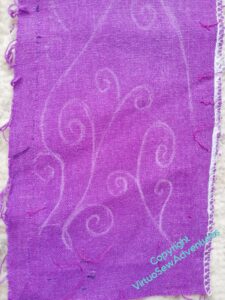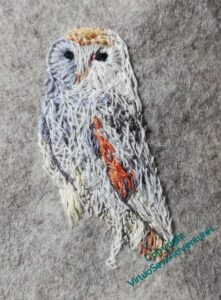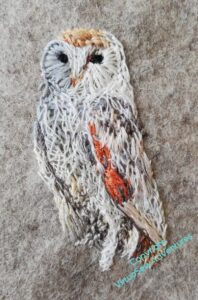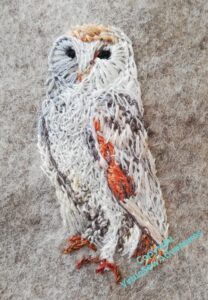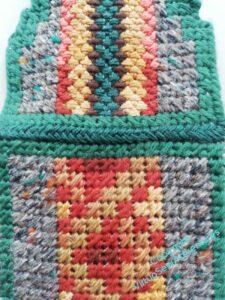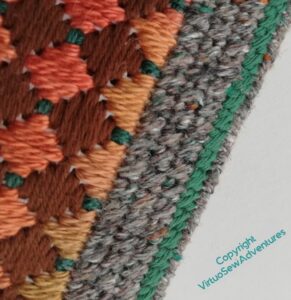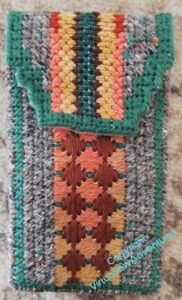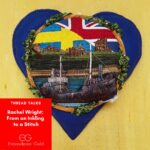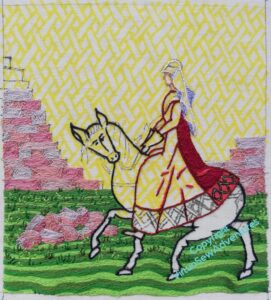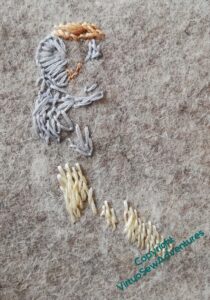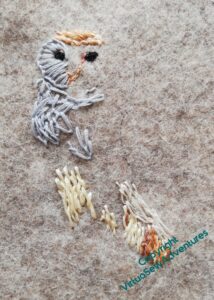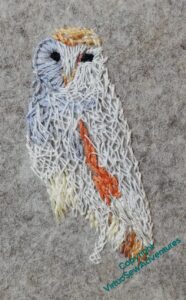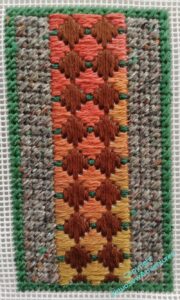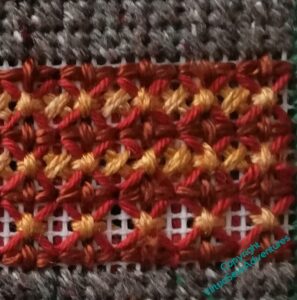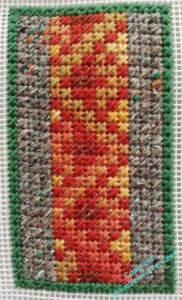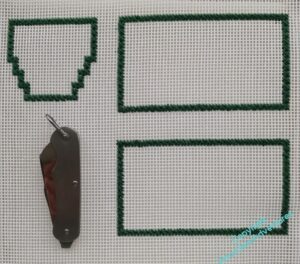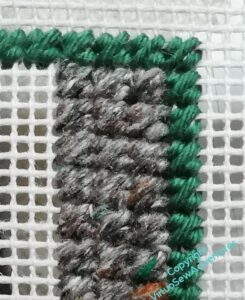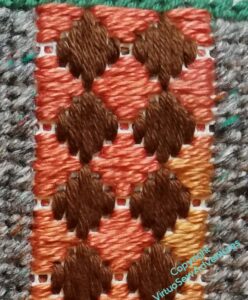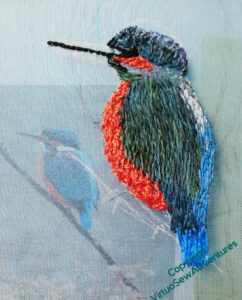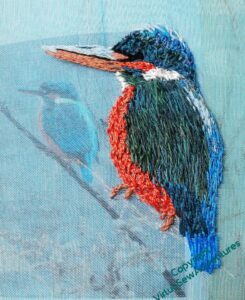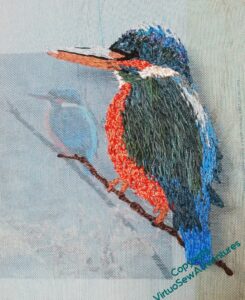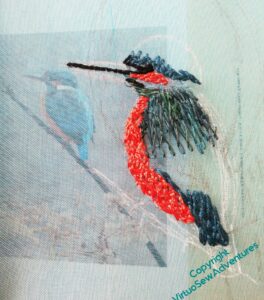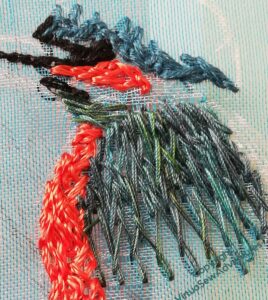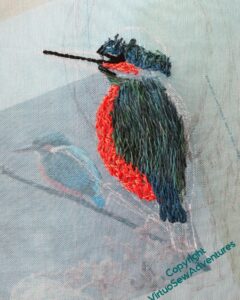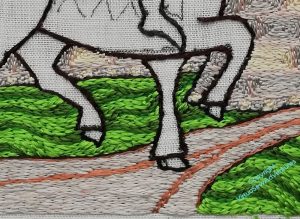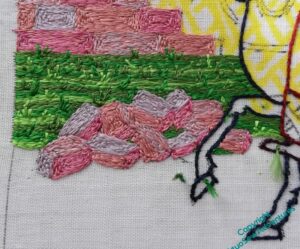About Rachel
View all posts by Rachel
Un-idling My Hands
I would like to have a small pencil bag to take sketching, and I’ve been finding myself in the evening, fidgeting because I can’t concentrate on the complicated stuff and my crochet has fallen so far out of my head that I am contemplating pulling the whole lot out (most of one sock, from rib to the beginning of the toe) and starting again.
And yet I would like my hands not to be idle.
I’ve just taken a pair of side panels out of a skirt, so I’ve pressed one of those panels and drawn some rough fernlike curlicue things on the fabric in chalk – just freehand, nothing complex, no attempt at evenness, just a sense of balance and an all over pattern.
Then I went rummaging for a thread that would live happily on the fabric. This is quite a heavy thread on a cardboard spool, and I’ve not the vaguest idea where it came from. It varies from a very dark teal to a lighter version of the purple of the fabric, and it’s going well so far.
Strictly speaking that thread is on the heavy side for the fabric, and I may find that coming back to bite me, but for now, my little homage to the “Fernmania” that brought you the scrolls on custard creams is going well.
When I’ve done the whole length I will need to decide, do I line it with the other side panel or save that to make another bag with? Little drawstring bags are always useful, after all….
Finishing The Penknife Case
The penknife case came together fairly well in the end.
Some years ago I settled on a satisfactory way of joining two canvas pieces at an edge. It’s a sort of long armed cross stitch, which goes into each hole twice. That means it’s fairly secure, but doesn’t take security to excess, and it’s easy to do, even when I’m a bit weary.
I used the dark green thread I used on the front for the cross stitches, and I think the top, “hinge” seam has turned out well, if a little stiff.
For the side seams, having run out of the green, I used the grey mottled thread.
That was a bit more of a challenge. I didn’t quite have to heave the needle through with pliers, but it was, nevertheless, quite an effort at time.
I don’t think this seam is going anywhere in a hurry!
However, it’s all nicely finished and secure now, and I didn’t buy any thread at all for it. Or canvas. Or felt to line it with.
Given how often avowedly “Stash Busting” projects turn into “Stash Growing” projects, I am going to take that as a significant win!
I believe that by now, anyone who signed up for my talk a couple of weeks ago should have received access to the recording.
Thank you to those who were there at the time, and thank you for the kind comments I’ve received. Please do ask more questions if they occur to you!
I’ve not forgotten Aethelflaed…
… although I will admit that sometimes I don’t manage to fight away all the things that get between me and my frame at a time of day when I have any chance of stitching her sensibly!
However – I’ve done the grass!
Well, I stopped doing tussocks when I thought I might want to do more extensive tussocks in the foreground, and decided to do the horse first, in case I wanted seedheads nodding over its legs. But apart from the tussocks, the grass is done.
However, that means I now have a decision to make…
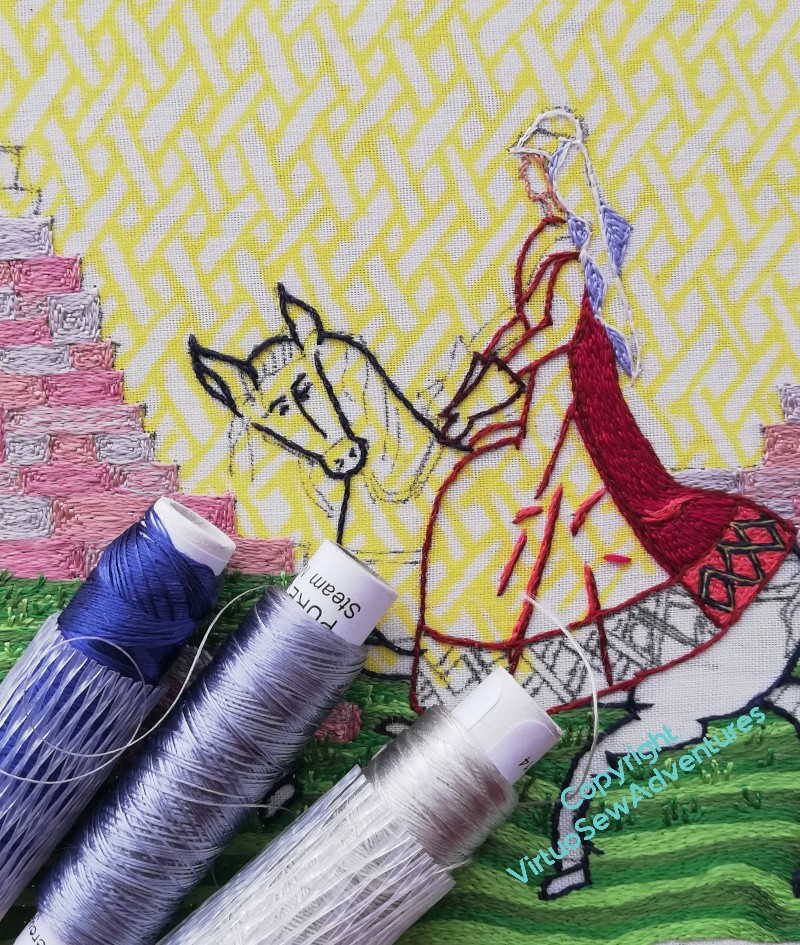
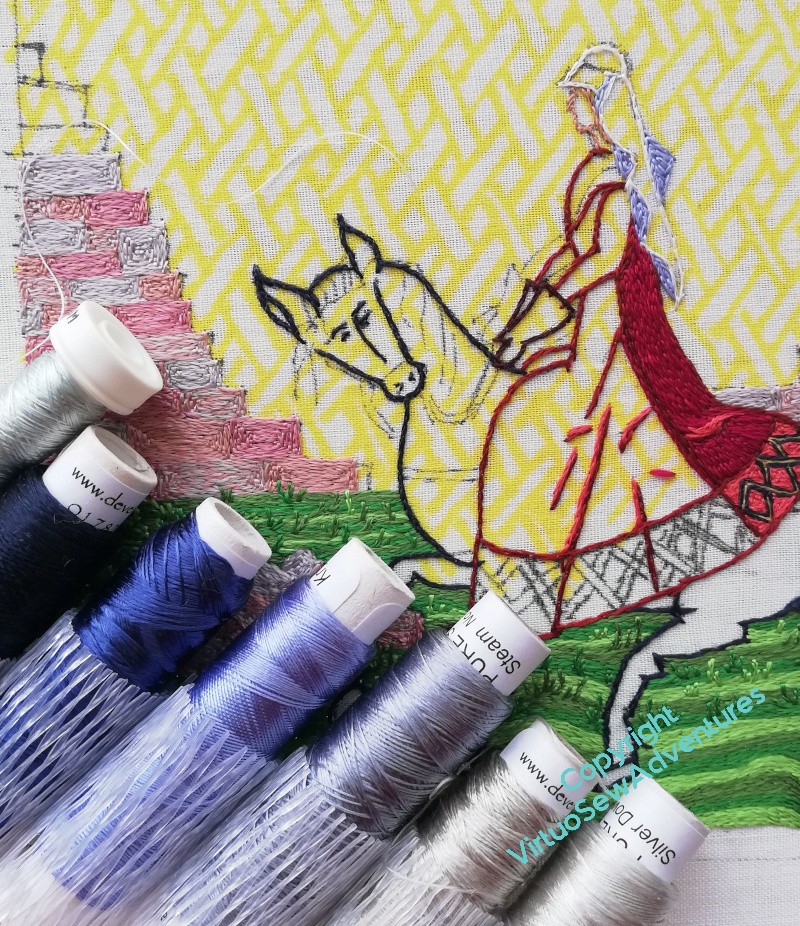
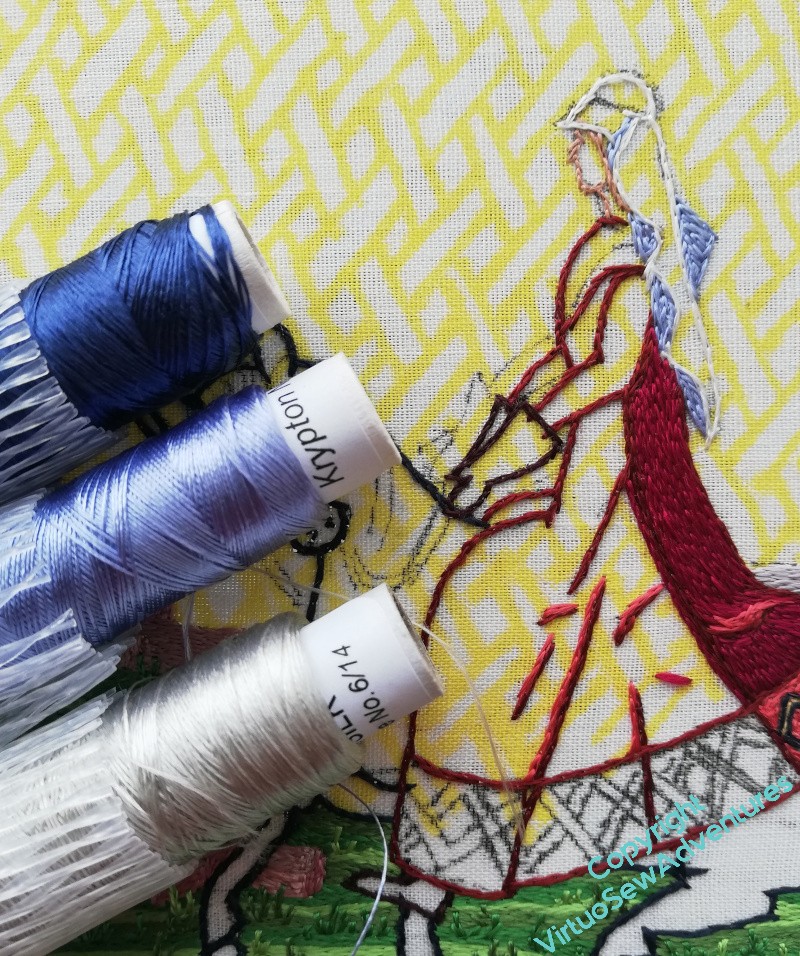
I’ve decided she’ll be mounted on a grey (contrasting with William The Marshall’s chestnut), and that it will be grey tending to blue. But which blue, and how much blue, and what colour should the lightest shade be? This is going to be important, as I think I’m not going to do dapples this time, just shading and a smooth coat.
Some thinking required…
More on the Canvaswork Penknife case
When you last saw this panel, there were gaps. They’ve now been filled with green cross stitches.
Yes, that works, I like the way the Caron Collection Watercolours thread runs from yellow to orange, the brown provides a bit of stability, and the green ties the inside and outside together. . It’s not the stitch pattern I was aiming for (I’m not sure what went wrong), but I like it.
However, that was, if I am honest, the last easy thing about this canvaswork!
I wanted to put a different stitch on the back, maybe more hardwearing, because I was considering using the finished object on belt loops. This, however, isn’t it.
Again, somewhere along the line it’s not the stitch pattern I was aiming for, and I’m not sure quite what happened. Suffice it that reading charts and diagrams seems to be a somewhat episodic skill for me, and I am at present in an “Off” period!
Furthermore, the coverage I want is requiring too many passes, too much tangling, and looking altogether too busy. Out it comes!
In the end, I went back to Mosaic Stitch.
It is built up in a rather haphazard fashion of zigzags, starting with two rows in the Watercolours thread, again, then moving outward with soft cotton in two shades of brown and adding a few details in a goldeny mustardy pearl type thread that I think is absolutely gorgeous. Unfortunately I’ve not the vaguest idea where I got it from, or when. It might even be silk – and here’s me putting it on a cover for a penknife!
Oh well, better to enjoy using it than have it sitting in a box asking me When it will Get A Chance To Play!
Now – a very exciting thing! – I shall be giving a talk for the Embroiderers Guild on June 3!
I believe I’ve turned this image into a link to the Eventbrite page, and for anyone not in the right timezone, or otherwise occupied on the day of the talk, the Guild makes recordings available for some time afterwards.
I shall remind you every week until it happens!
Penknife Case In Canvaswork
I’ve decided this penknife needs a case. (Of Course I Have!).
Canvaswork is often a good choice for this sort of thing, and I’m going to try to keep to stash. That may make things a bit harder, because my canvas is not especially fine, and as it turns out I don’t have much that’s suitable for that count of canvas.
I have prior experience of making something that ended up too small to do the job, so this looks very much too big. By the time it’s done, it might be the right size, but if it’s too big, even with padding and lining, I’ll simply start again, and use this for something else!
I actually started with the grey flecked yarn. It has flecks of green, and a browny-orangey colour, so I thought that might make an interesting challenge to combine. The panels are outlined in Mosaic Stitch, using a soft cotton in a green that goes with the green flecks. The grey had to be used double, so I think this is going to be quite a close run thing to get to the end with enough yarn to do the job!
The next panel started as Pavillion Steps, from Jo Ippolito Christensen, but I couldn’t quite make sense of the diagram, so it’s become something much simpler. Caron Collection (Wildflowers, I think) in one direction, soft cotton in the other, both of them used double to achieve reasonable coverage.
It’s clear I need to fill in that gap with Something, so now I need to rootle around in the stash to find something suitable. Several somethings suitable, in fact, as I don’t think the remaining stock of these threads will be enough for the rest of the case. I can do more Mosic stitch on the back, perhaps, but making sense of the top flap if I can’t run the same pattern across it is going to take a bit of thinking about.
Now – a very exciting thing! – I shall be giving a talk for the Embroiderers Guild on June 3!
I believe I’ve turned this image into a link to the Eventbrite page, and for anyone not in the right timezone, or otherwise occupied on the day of the talk, the Guild makes recordings available for some time afterwards.
I shall remind you every week until it happens!
Finishing The Kingfisher
The kingfisher has been really quite tricky, but rewarding, too.
I do enjoy these colours, for a start, and the chance to use the really glossy rayon thread that helps his bright orange breast to shine. For the bright stripe of his back and tail, I’ve ended up combining threads in the needle to get just the colour I want. Even with a full range of Madeira stranded cotton in my thread stash, the precise colour and tone weren’t quite there. There’s another variegated mercerised machine thread in the mix as well – I think the motto for this piece is going to be “Whatever It Takes!”!
When I looked closely, I realised that the lower beak and the little claws were a very similar colour. The feet have been made a little scalier by stacking single twisted chain stitches atop one another so that they narrow into claws.
I’ve made the dark line of the beak narrower by bringing split stitches close in on either side, and done a lot of staring and adding little areas – the top of his head, the white flash at the side of the head, and the tiny bit of white at the throat. When I put him wherever he ends up, that will be one of the push-pull elements that helps him to detach sufficiently from the background to do his job.
Finally, I decided that the couple of bits of dark showing the underside of the far wing did in fact need to go in – more of the push-pull.
Then he wanted a twig to sit on. When I come to set him in place, I may cut some of the fabric close or turn it under, but other parts may be left so that the blue gauze modifies whatever is underneath. Some of this twig may be undone, some of it may be enhanced and extended.
I am reminding myself that I don’t work my best when I’m fretting about the Whole Thing. I do very much better when I get started and work out the whole thing later. I need to read the book again, to see whether there are particular animals I have to include. That will be no hardship, it’s a much beloved book!
I shall be giving a talk for the Embroiderers Guild on June 3!
I believe I’ve turned this image into a link to the Eventbrite page, and for anyone not in the right timezone, or otherwise occupied on the day of the talk, the Guild makes recordings available for some time afterwards.
I shall remind you every week until it happens!
The Kingfisher Continues
The kingfisher is proving more complex than some of the earlier animal vignettes. This is partly because the shape is complex, and partly, I think, because this is one of the elements I really want to include, so it’s hard to “play” quite so freely!
The lower stitching – part of the wings, maybe, or the tail? – is densely stitched in stranded cotton, and the head is small, tangled stitches again in stranded cotton. The original photograph that I’m using as a guide shows much smaller speckles of colour over the head, so the smaller stitches should help with that..
I’ve put a line down the beak which I need to make narrower as I stitch the rest of the beak, and I’ve started on the wing.
You can see in this close up that I’m using two strands of a variegated mercerised cotton for the wings, overlapping and tangling my Cretan Stitches to create something like the effect of the feathers. Considering that fluffy effect it has created for fur in some of the other Vignettes, I’m astonished and delighted that it’s not looking fluffy this time. The colour helps, of course, and the stitches are more closely packed, but still, I’d not realised until now just how versatile Cretan Stitch is!
I’m very pleased with progress so far. I need to find the right bright shade for that stripe down the back and the end of the tail, fit in his white collar, and the bright colour on the top of his head, and then work out how to keep the beak neat and crisp.
So far, that’s defeating me, so wish me success, please…!
A reminder that I shall be giving a talk for the Embroiderers Guild on June 3!
I believe I’ve turned this image into a link to the Eventbrite page, and for anyone not in the right timezone, or otherwise occupied on the day of the talk, the Guild makes recordings available for some time afterwards.
I shall (continue to) remind you every week until it happens!
Tackling Stones And Tussocks
You may recall that when I was stitching William Marshall, I chose to use more strands of silk in the needle, and to stitch relatively calm curves and unevennesses in the ground. I wanted to suggest that William’s kinsman kept the land around the walls of his stronghold close clipped (by grazing, one presumes) so as to ensure that he could not be take too much by surprise, whether by welcome or unwelcome visitors.
Aethelflaed, of course, is visiting, in effect, a building site. She has no road, and her horse is picking its way around heaps of building stone and over grass that’s tussocky and and uneven. I gave some thought to the question of how to represent that, staying true to the aesthetic, using only silk and split stitch, but creating some of my own variations. After all, this is modern, inspired by the past, not a reconstruction of an existing piece. I have a little freedom of movement here!
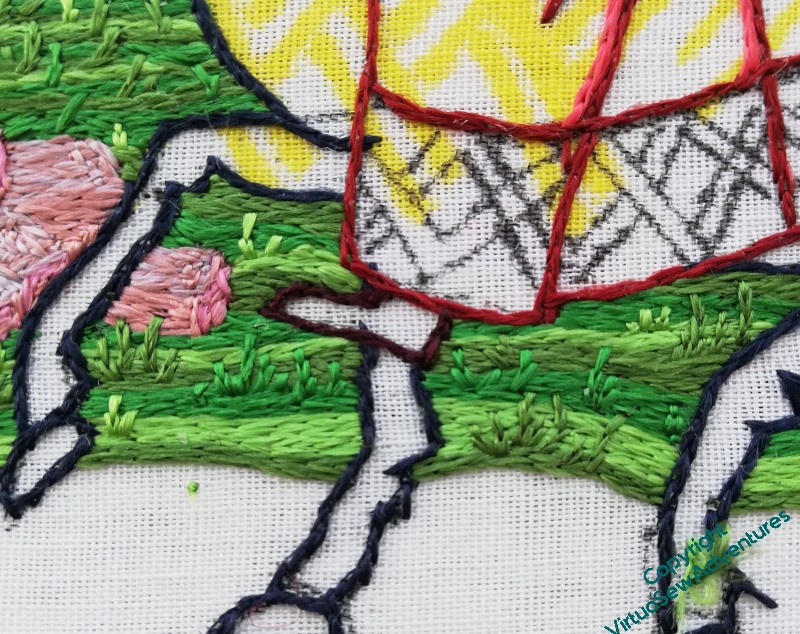
So I’m using three different greens, and I’ve not increased the thickness of the silk in my needle. I’m not stitching the curves quite as regularly, and I’ve devised a way to stitch little tussocks at uneven intervals across the ground. They are just little groups of split stitch lines crossing the flows of colour, but I think they are working rather well so far.
It has only just occurred to me, however, that I may have a slight tweak to make in my process for doing them, as I come forward: they need to get bigger, cross more of the lines of colour. Do I now just put the colour in, so that small tussocks don’t compete visually with large tussocks, or do I just carry on regardless?
Now, a reminder that I shall be giving a talk for the Embroiderers Guild on June 3!
I believe I’ve turned this image into a link to the Eventbrite page, and for anyone not in the right timezone, or otherwise occupied on the day of the talk, the Guild makes recordings available for some time afterwards.
I shall remind you every week until it happens!

